Instructional Series
This site will be closing soon as its content has moved to Tāhūrangi.
2024 titles are available on Tāhūrangi. Use the filters to find specific series.
Find Literacy resources at Tāhūrangi - Literacy.
Welcome to the English medium literacy instructional series teaching and learning resources for years 1 to 8.
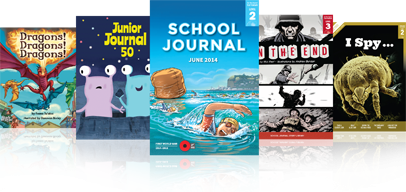
- Gold
- Purple
- Magenta
- Yellow
- 3
- 4
- 2
- 1
- 6
- 4
- 5
- 8
- 7
- 3
- 1
- English
- Social Sciences
- Science
- Health and Physical Education
- Technology
- Mathematics and Statistics
- The Arts
- Non-fiction
- Fiction
- None
- Nature of science
- Geometry and Measurement
- Living world
- Planet Earth and beyond
- Nature of technology
- Physical world
- Number and Algebra
- Statistics
- Technological knowledge
- Material world
- Technological practice
- Engage with science
- Gather and interpret data
- Interpret representations
- Use evidence
- Articles
- Stories
- Poems
Search results
166 items - Showing 11 - 20
-
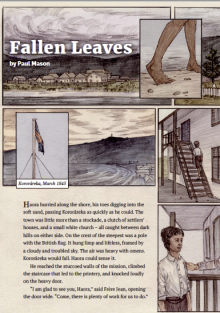
Fallen Leaves
by Paul Mason
This historical fiction, set in 1845, is told from the point of view of a young Māori protaganist. Haora works in the printery at Kororāreka at the time when war was building between Ngāpuhi chief Hone Heke (Hone Wiremu Heke Pōkai) and the British troops.
-
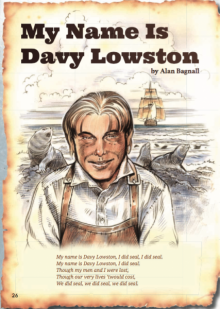
My Name Is Davy Lowston
by Alan Bagnall
illustrations by Spike Wademan
This text is a fictionalised recount. Davy Lowston was among a group of sealers set down on the Open Bay Islands (off the west coast of the South Island) in 1810. The ship that was to pick them up sank in a storm, and the men were marooned for four years. Their story is the basis of one of the earliest folk songs in New Zealand.
Listen to the song of Davy Lowston:
-
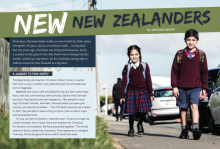
New New Zealanders
by Adrienne Jansen
illustrated by Adrian Heke
This article introduces readers to a family who have escaped war-torn countries in the Middle East and have now embraced the freedom and safety that New Zealand offers. However, settling as refugees has its own challenges. We learn about the reasons the Kaka family had to move from Iraq to Syria, on to Lebanon, and then to New Zealand.
-
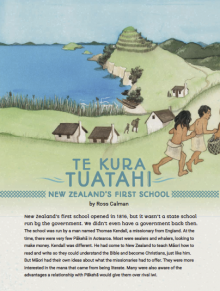
Te Kura Tuatahi: New Zealand’s First School
by Ross Calman
Two hundred years ago, our first school opened at Rangihoua.
-
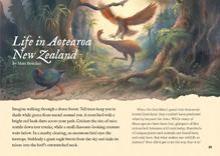
Life in Aotearoa New Zealand
This article describes the evolutionary development of life in Aotearoa New Zealand and addresses the question of why our flora and fauna are so distinct. It introduces and explains the concepts of evolution and adaptation and offers a brief overview of how the land itself changed over many millions of years.
-
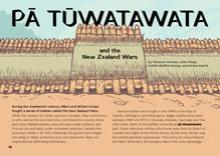
Pā Tūwatawata and the New Zealand Wars
This article describes the development of pā technology in the nineteenth century, as iwi and hapū defended themselves and their land against invasion. It explains how the basic features of pā technology were adapted in response to invasion by Pākehā – utilising the rich knowledge Māori held about their land.
-

Marcus Thomas: New Zealand Caveman
interviewed by Susan Paris
Marcus Thomas: New Zealand Caveman presents an engaging account of why Marcus took up caving. His passion for caving as a child led him to contact the New Zealand Speleological Society, and he has gone on to explore many of New Zealand’s longest and deepest caves. The article is structured as an interview, with the interviewer’s questions forming the headings.
-
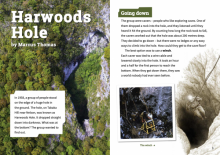
Harwoods Hole
by Marcus Thomas
In 1958, a group of intrepid cavers descended into Harwoods Hole, a huge vertical chasm on Takaka Hill. At the bottom, they discovered a spectacular environment, with beautiful stalactites and waterfalls. A month later, they discovered a second cave nearby. The cavers proved that the two cave systems were connected and created a way to travel between them. The themes of exploration and discovery make this article an enthralling read. It’s also an excellent introduction to the information texts students will be encountering more frequently as they progress through school.
-
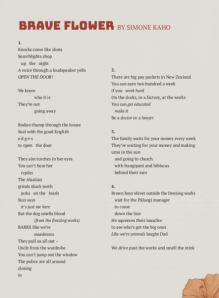
Brave Flower
by Simone Kaho
illustrated by Leilani Isara
The poem “Brave Flower” vividly captures the experience of those who were subjected to the dawn raids that took place in Aotearoa in the 1970's.
-
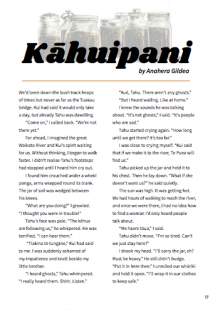
Kāhuipani
by Anahera Gildea
illustrated by Andrew Burdan
Based on a true story, Kāhuipani details the journey of two children to the Tuakau bridge to find Te Puea, a young woman who cared for more than 100 orphans during the influenza epidemic of 1918.






 Literacy Online home
Literacy Online home
